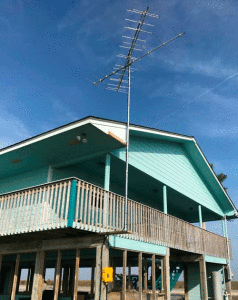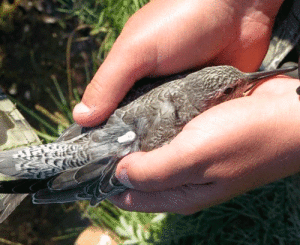
Motus towers are places along the Texas coast to receivedmigration data form birds crossing their paths.
Photo by Susan Heath, GCBO
For decades, bird biologists have been trying to track the movements of birds in numerous ways. Finding bird migration paths, breeding grounds or wintering grounds was not always an easy task. Today we still don’t know where some birds go. Banding birds with fine metal bands on their leg with an individual number was one way to keep track of them. But that required someone else to re-catch that bird somewhere. Monitoring sites suspected of being a winter habitat was labor intensive and expensive and could take years.
Along came modern tracking technology, and before long it was adapted for wildlife tracking. Bears and wolfs were fitted with GPS location trackers, and similar devises were used for other animals. Whales and sharks were tagged with little sensors, and sea turtles had GPS trackers glued to their shells. And eventually technology produced smaller and smaller devices that could be fitted on large birds. Eagles and hawks were tracked for up to 2 seasons showing their long, often meandering, flights in migration. But until more recent years it was not possible to do so with smaller birds due to the weight of the device.
The Motus Wildlife Tracing System was developed in Canada by Birds Canada in partnership with collaborating researchers and organizations. Motus is Latin for “movement”, an appropriate name for this system. Motus is now an international collaborative research network that uses a coordinated automated radio telemetry array to track the movement and behavior of small birds and other organisms affixed with digitally-encoded radio transmitters (nano-tags). These tags broadcast signals several times each minute. The signals are detected by automated radio telemetry stations that scan for signals 24 hours a day, and 365 days a year. When results from many stations are combined, the array can track animals across a diversity of landscapes covering thousands of miles.
Radio telemetry uses radio signals, which are made up of invisible and silent electromagnetic waves, to determine location. A radio telemetry system is made up of three parts: a radio transmitter (in this case a very small radio transmitter called a nano-tag), a radio antenna (looks like an old roof TV antenna), and the radio receiver and computer gear that records it.
Gulf Coast Bird Observatory and the Texas Midcoast National Wildlife Refuge Complex initiated a Motus project in 2016 to establish a network of Motus Towers along the Texas coast. We worked with partners to install 15 Motus towers creating a “fence” which migrating birds will pass through during spring and fall migration. These towers are augmented by two to the north and four to the south which nearly completes a network along the entire Texas coast. Birds outfitted with nanotags that migrate through this “fence” will be picked up by the towers and the data will be recorded.
So why does all this matter? One reason is to learn the migratory paths and timing of bird species. For neotropical migrants, we spend a lot of effort saving habitat on their northern breeding grounds and in their southern wintering grounds. But unless birds have stopover sites to rest and feed during migration, they will never complete that migration. Without migration, there wouldn’t be any of the beautiful birds that return to the U.S. each spring to breed. Knowing what areas and sites are the most important for migratory birds is crucial so we can also try to save those sites. That is getting harder and harder to do as birds often use coastlines, which are being rapidly developed.
So, if you ever see what looks like a TV antenna on a coastal refuge or sanctuary, or maybe even on a house, it may very well be one of our Motus towers silently monitoring bird migration data!

A tiny Nano tag that emits a signal is attached to birds.
Photo by Susan Heath, GCBO
